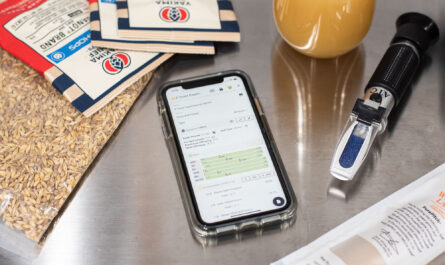At a basic level, mash recirculation typically helps with maintaining consistent mash temperature throughout the grain bed in non-insulated or indirectly heated mash tuns. During recirculation, wort is pumped from the bottom of the kettle (closest to the heat source in my case) and returns to the top of the mash tun. I recently started using the Exchilerator Sparge Arm to recirculate my mash for my electric brew in a bag setup. Overall, my goal was to further automate my process and eliminate heat loss towards the top of the mash.
Mash recirculation has become pretty popular with most turnkey electric BIAB systems, but it’s is especially useful in a traditional 3 vessel system. Recirculating the mash will greatly help to clarify/filter the wort through the grain bed before it’s transferred to the boil kettle.
While the wort will certainly start to clarify with BIAB through recirculation, the result will likely be negated when the bag is removed and drained, especially if the bag is squeezed (the inability to produce clear wort is one of the few downsides with BIAB). In order to recirculate the mash, you will need a brewing pump, silicone tubing, and a method to carefully return the hot wort over the mash tun.
Recirculation and Efficiency
A common misconception of BIAB mash recirculation is improved efficiency. Only a finer crush and proper mashing temps will impact BIAB efficiency. Mash recirculation however is highly beneficial in step mashing or when trying to quickly and uniformly raise the temperature of a mash. You can of course also achieve with constant stirring, but it’s obviously a lot more labor-intensive and not automated.
The Sparge Arm
I use Exchilerator’s Hangover and Sparge Arm attachment to recirculate my mash. It’s adjustable, easily clips onto the side of the kettle, and does a good job of evenly distributing hot wort over the top of the mash. I’ve tried a few different methods but this is by far my favorite tool. I’ve experimented using simple return tubing with a float ball but it always seems to displace the grain and does not evenly distribute wort.
The design of the Sparge Arm is simple and made with stainless steel. This makes for easy cleaning, setup, and breakdown. Because it snugly attaches to the top of the kettle (the clip is contoured to fit the kettle wall—it’s well designed), you don’t have to modify the grain bag or cut a hole in it to make room for any accessories. Not to mention you don’t have to modify the kettle itself.

My Ss Brewtech kettle has a built-in side port at the top of the kettle, but it’s too low for larger batches or hefty grain bills. Going over the side of the kettle or through the lid were my only options. Lastly, the Sparge Arm is easily adjustable so I can slide it down for small batches or slide it all the way up for larger batches. It also comes in two lengths, 8″ and 12″ (the 8″ is pictured on my 10g kettle).
FYI, Exchilerator also sells a Whirlpool Arm attachment among other accessories that you can interchange throughout the brew day. I also used the Whirlpool Arm before ultimately making some more permanent kettle upgrades and switching to primarily TC fittings.
My Configuration
You can accessorize the Sparge Arm with whatever 1/2 inch NPT fitting you would like. I added a male quick disconnect so I could easily integrate it with my system. A 1/2 inch Auto Siphon clip works really well for securing your tubing to the kettle handle so it doesn’t bend or kink at the top. This is especially useful when the tubing is flowing with hot wort. Note, you may want to cut a small piece of 3/4″ ID/1″ OD tubing so the clip fits more snugly around the tube. Stole this idea from Brew Hardware.
The only real downside to my setup is the cost. To get up and running with this configuration will cost you about $100. This includes both the Hangover Clip and the Sparge Arm attachment (sold separately). There are other cheaper alternatives out there but I’m not sure they are as easily implemented as this one. The other things to consider with any recirculating method is the cleaning process and clogging risk. The opening/body on the Exchilerator Sparge Arm is large enough to easily pass any grains—I don’t have any concerns with clogging it. It’s also really easy to quickly rinse after brew day.
Cleaning, clogging, and avoiding as much plastic as possible were my biggest priorities when evaluating any sort of recirculation system. Overall, I’m really pleased with the flexibility of the Sparge Arm and I would highly recommend it as a recirculating solution for BIAB and both recirculation and sparging on a traditional 3V system!
Brew Bag Choice and Recirculation
As a quick final note, If you plan on recirculating your mash with BIAB, a 400-micron brew bag is recommended. This helps to prevent a stuck mash when recirculating. The risk comes with actually draining all the wort from under the bag and dry firing your electric element or scorching your kettle. It’s hard to believe but the grain bag can actually create a vacuum and prevent wort from flowing freely through the kettle. I have not experienced this personally but have heard horror stories.








Bonjour !!
Quel système utilisez vous pour chauffer votre cuve et gérer la température ??
Merci beaucoup !
DAMIEN.
Brew Commander with 5500W ripple element